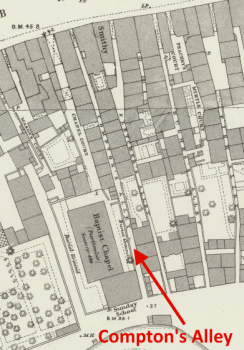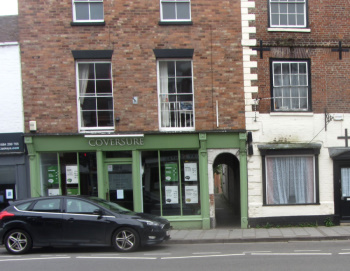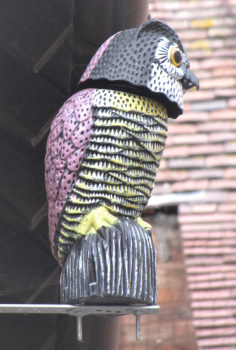Compton's Alley
to Expand
Compton’s Alley is named after the Compton family who occupied the ‘front house’, 77 Barton Street, for over a hundred years. They were a dynasty of cabinet makers. The last, Theophilus Compton, ran an extensive business making and retailing furniture, with a warehouse in East Street. After his death in 1903 the property was sold. In 1995, three sets of ledgers were found in the attic. Two were Theophilus Compton’s order books from the 1870s, giving an interesting insight into his business life. These were the subject of another article - 77 Barton Street.
The alley runs between Barton Street and Swilgate Road, the most westerly of a series of alleys off Barton Street, the most complete group in the town. It sits alongside the plot which once contained the Star and Garter Inn, the rear of which became Tewkesbury’s second Baptist chapel, the old inn entrance becoming Chapel Court.
Compton’s Alley contained thirteen cottages at the 1841 census which had reduced to ten by the beginning of the twentieth century. A sale notice from 1837 for a stable in the alley states that it could be converted to a cottage, so there was some flexibility of use, though there must have been some difficulties in manoeuvring horses in the confines of an alley and what they were like as neighbours is anyone’s guess!to Expand
In 1841, three cottages were empty, six were occupied by framework knitters or stocking makers and one by a needle-maker, which shows the importance of the industry to Tewkesbury. Over time, numbers reduced until in 1881 there were just two stocking makers.
It was a quiet alley compared with some on the High Street but it was still riddled with poverty and it had its tragedies. Where there is proximity to water, small children died, and in 1886 Selina Barratt, aged three, went out to play with other children, fell into the Swilgate and drowned. Some years earlier, Emma Cooper, a child of less than three years burned to death when left with her siblings whilst her mother, described as a ‘poor woman’, went out to work as a char woman. The little girl had been standing before the fire to warm herself, and her clothes caught fire.
There were other tragedies and some mysteries. In 1905, Charles Kirk, a ‘somewhat eccentric’ chimney sweep, who lived alone left his home in Compton's Alley to walk to Ashton-under-Hill, and then to return home by train. He was seen at Conderton, but nothing further was seen of him and no clue to his whereabouts was ever discovered. In 1913, Elizabeth Chamberlin was sentenced to one month’s hard labour for neglecting and ill-treating a child. She had starved her illegitimate baby to death, so it seems a very lenient sentence.
There are always court appearances, in the main arguments which got out of hand because of the stresses of living in such close proximity. For a short while Susan Evans, alias Black Sal, lived in the alley with her sister’s family. She was once described by Inspector Selwood as an Intolerable nuisance, and her many court appearances for petty theft and peddling suggest that he was probably right.
The alley suffered from many of the same problems as other alleys as regards hygiene and sanitation. Its first wash-house and toilet block was built at the foot of the alley, on the bank of the Swilgate. Demolished in the 1960s, this was known locally as Tommy Craddock’s Duckhouse, though Tommy Craddock seems to have faded from memory.
The cottages in the alley came under early scrutiny after 1918, when the rehousing programme started. In 1920, three houses were declared unfit for habitation and a closure notice was issued. In 1933 it was the turn of the rest of the alley. The bureaucratic process was slow and tortuous. A demolition order for six houses, owned by Mrs Halling, was recommended in 1934. There was a stay of execution for some in 1935, when they were refurbished as temporary accommodation for displaced families. By 1937 the Borough Surveyor was reporting that the last condemned house was being demolished.
The character of the alley is now very different to what it was. There are few houses. Those which have survived are much altered. The old locations of doors can be traced in the alley brickwork but layouts have been changed considerably. Some, at the lower end of the alley, are modern. The creation of apartments in the adjoining old Baptist chapel opened up the southern end of the alley and changed the aspect completely. The Barton Street entry remains much as it was (except for the replacement of blue bricks with concrete equivalents). It contains its own public art; not alley cats, but alley owls.
Census Data 1841-1891
- Births: Tewkesbury 11 429 Mar 1839: Cook John FreeBMD





Comments
Saturday 10-May-2025 by: Steve Carter
I’ve stumbled on this article as I’m researching my ancestry. John Carter (1851 census) is my 3rd great grandfather! By the next census in 1861, John has moved to Birmingham and the family line on my Dad’s side stayed there ever since until I left for pastures new! It is a very interesting article and if there is any further information regarding the Alley I would love to see it. Please get in touch via my email.
Thanks for putting together such an interesting piece.